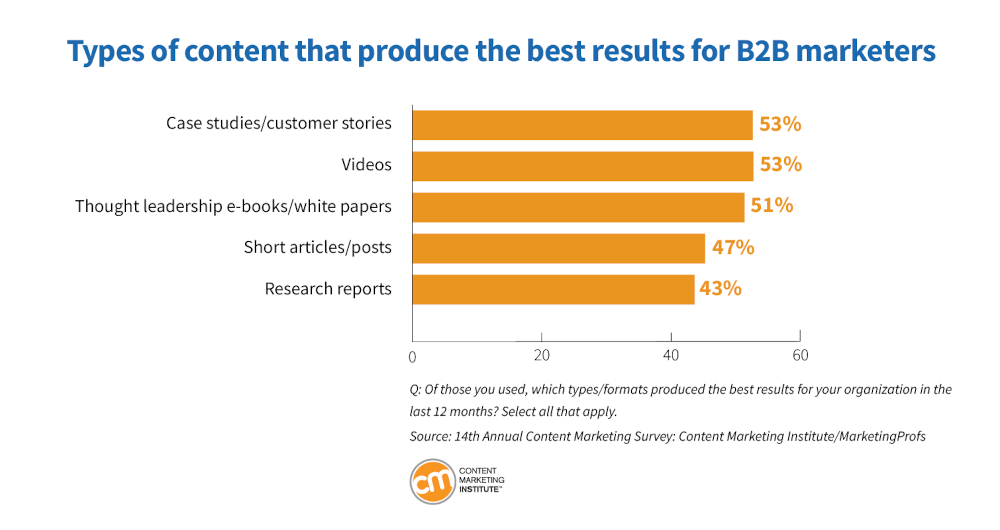B2B content syndication has emerged as a powerful strategy for businesses to amplify their reach, generate high-quality leads, and enhance brand awareness. With 46% of B2B marketers focusing on improving their content distribution channels, content syndication has become a crucial component of effective content marketing efforts.
What is B2B content syndication?
B2B content syndication is the process of republishing your content on third-party websites, platforms, or channels to reach a wider audience. It involves taking your existing content assets like blog posts, whitepapers, eBooks, webinars, and allowing other relevant sites to republish or share your content with their audiences.
Content syndication differs from traditional content marketing in that your content is being promoted and distributed through external channels rather than just your own website or platforms. The goal is to leverage the established audiences of publishers and influencers in your industry to drive more visibility, website traffic, and leads back to your business.
How B2B content syndication works (and generates more leads)
B2B content syndication involves a strategic process to effectively distribute and amplify your content to targeted audiences and generate quality leads. Here’s a step-by-step look at how it works:
1. Create quality content
Did you know that 88% of B2B buyers trust a brand more when they receive valuable content from that vendor, according to our tech buyer research? This statistic highlights the critical role content plays in B2B marketing.
High-quality, engaging content is essential for successful B2B content syndication. Your syndicated content must deliver value and insights that resonate with your target audience. Focus on creating original, well-researched pieces that position your brand as a thought leader in your industry. Ultimately, this well-crafted content is key to driving successful syndication outcomes and building lasting trust with potential customers.
2. Identify effective content formats for syndication
While certain content types naturally excel in the syndication space, the key to success lies in aligning your format with both your audience’s preferences and the latest industry trends.

Here are refined tactics for selecting the most effective content formats:
- Whitepapers and eBooks: According to the Content Marketing Institute, this format is highly effective, producing great results for 51% of B2B marketers. Before creating in-depth resources, conduct surveys or utilize analytics to understand the topics your audience is interested in. Tailor your content’s complexity and depth to their specific needs, ensuring it addresses their challenges directly
- Case studies: Case studies and customer stories are a top-performing content type, with 53% of B2B marketers finding them effective. When showcasing success stories, choose clients that mirror your target audience’s profile. This approach makes your case studies relatable and demonstrates your understanding of their unique challenges
- Webinar and video content: Videos are another highly effective format, producing top results for 53% of B2B marketers. Leverage the power of storytelling through multimedia. Create a series of webinars or videos that collectively guide your audience through a journey, offering valuable insights. Use analytics to identify the most engaging topics and formats, such as live Q&A sessions or tutorials
- Industry reports and research studies: Conduct original research that taps into current trends or unanswered questions within your industry. Although slightly less popular, with 43% of B2B marketers finding them effective, research reports can still enhance the appeal of your content and position you as a leading voice on emerging issues
3. Define your Ideal Customer Profile (ICP)
Before launching a content syndication campaign, it’s crucial to have a clear understanding of your ideal customer profile. An ICP outlines the characteristics of companies and decision-makers most likely to benefit from your products or services. This detailed profile helps you create targeted content that resonates with your target audience, increasing the chances of generating high-quality leads.
4. Build your target account list
Armed with your ICP, the next step is to build a targeted account list. Leverage various data sources, such as your existing customer database, industry research, and third-party data providers, to identify companies that fit your ICP criteria. This targeted approach ensures that your syndicated content reaches the right decision-makers within your ideal accounts, maximizing the effectiveness of your campaign.
Not sure where to start? Claim your free ABM target account list with Inbox Insight and kickstart your strategy today.
5. Design your campaign and utilise the best content assets
Develop a comprehensive content syndication campaign that leverages your best-performing assets. This may involve repurposing existing content or creating new pieces specifically for syndication.
Consider which collections of content will work best when engaging new leads for your brand. Map the product lines you want to grow to the topic areas in your content.
6. Select a content syndication partner
Choosing the right content syndication vendor is critical to the success of your B2B strategy. As you evaluate potential syndication partners, consider factors such as their reach and audience relevance, content distribution channels, pricing models, reporting capabilities, and overall reputation.
Popular B2B content syndication platforms include Insights for Professionals. This platforms offer access to targeted audiences, lead generation and nurturing tools, and performance analytics. However, be sure to thoroughly vet each platform to ensure it aligns with your specific goals and target audience.
When negotiating terms with syndication partners, be prepared to discuss pricing structures (cost per lead, flat-rate packages, etc.), lead quality requirements, content usage rights, and performance guarantees. Many partners offer flexible pricing models to accommodate different budgets and campaign scales.
It’s also essential to understand the partner’s lead nurturing capabilities and how they will support your efforts to convert leads into customers. Inquire about their nurture stream options, lead scoring methodologies, and integration with your marketing automation and CRM systems.
7. Nurturing and converting leads
Once you have generated leads through content syndication, it’s crucial to nurture them effectively to convert them into customers. Here are some key steps to take:
- Set up nurture campaigns: Deploy automated campaigns that provide personalized, valuable content based on a lead’s interests, actions, and buying stage to build trust and guide them to sales readiness
- Align content to funnel stages: Distribute content appropriate to each stage of the buyer’s journey, from educational pieces for awareness to in-depth demos and case studies for those closer to a purchase decision
- Leverage lead scoring: Prioritize leads for sales engagement based on their interaction with your content and other behaviors, focusing on those most likely to convert
- Personalize the experience: Customize content recommendations and communications for each lead based on their particular needs and interests, utilizing data from previous campaigns for maximum relevance
- Seamless hand-off to sales: Ensure leads are only passed to sales once they meet predefined readiness criteria, equipped with comprehensive engagement data to facilitate effective, informed sales conversations
By diligently nurturing leads and strategically moving them through the sales funnel, businesses can significantly enhance the effectiveness of their content syndication efforts and boost their revenue.
What are the key benefits of B2B Content Syndication?
B2B content syndication offers several key benefits that can drive significant value for businesses:
Expanded reach and audience
One of the primary advantages is the ability to expand your reach to new and wider audiences. By partnering with established third-party publishers and platforms, you can tap into their existing subscriber base and visitor traffic. This increased exposure allows you to connect with potential customers who may have been previously unaware of your brand or offerings.
Higher quality leads
Content syndication enables you to target specific audience segments based on factors such as job titles, industries, company sizes, and areas of interest. By delivering tailored content to these targeted prospects, you increase the likelihood of generating higher-quality leads that align with your ideal customer profile. These leads are often further along in the buying cycle and more likely to convert into customers.
Enhanced brand awareness and engagement
Placing your content on reputable third-party sites can significantly boost brand awareness and credibility. As prospects engage with your syndicated content, they become more familiar with your brand and associate it with thought leadership and expertise in your industry. This increased brand recognition can lead to improved engagement and loyalty among your target audience.
Achieving a scalable return on investment
Effective content syndication campaigns can deliver a scalable return on investment by reaching a large number of qualified prospects at a cost-effective rate. By leveraging the established audiences of syndication partners, you can efficiently generate a steady stream of high-quality leads without incurring the same level of upfront costs as other lead generation tactics.
Monitoring and measuring B2B content syndication
Measuring the success of your B2B content syndication efforts is crucial for optimizing your strategy and maximizing ROI. Here are a few key metrics to consider:
- ROI: Calculate the revenue generated from syndicated leads against the total cost of syndication to determine ROI. Factor in variables like average deal size and customer lifetime value. Make sure to factor in your follow up rate and average sales cycle so you are leaving a long enough window to see results.
- Lead quality: Not all leads are equal. Monitor lead quality metrics like job titles, industries, company sizes, and sales-qualified lead rates. High-quality leads that convert are more valuable.
- Traffic: Analyze referral traffic from syndication channels to your website or landing pages. This insight helps identify top-performing content formats and partner sources
- Conversion rates: Track how many syndicated leads move through your marketing/sales funnel. Optimize content and nurturing campaigns to improve conversion at each stage
Advanced strategies and trends in B2B content syndication
As the B2B content syndication landscape evolves, businesses should stay informed about emerging trends and advanced strategies. For instance, intent data has quickly become the new standard for enhanced lead generation. Content syndication programs are no different.
Ensuring that your demand capture strategy includes targeting prospects when they are researching your category already will boost engagement rates and quality.
“We use an intent planning framework on every campaign that combines 1st party data from the Insights for Professionals platform with 3rd party data from content consumption across the market.
This gives us a window into the buying behaviour of the target audience before we begin promoting your content.”
Ross Howard, Product Marketing Director
Combining intent data at an account level with lead prioritization AI makes these signals actionable and helps you improve your results when following up. Precision targeting of buyers that are showing intent for your solution means that your content syndication leads convert at a higher rate.
Ready to capture in-market demand and generate qualified leads?
Leveraging B2B content syndication is a strategic approach aimed at propelling your business forward by attracting quality leads and expanding your brand’s reach. This method focuses on audience-centric content distribution through optimal channels to effectively engage potential buyers.
Effective content syndication involves prioritizing content that resonates with your Ideal Customer Profile (ICP), using high-intent data to guide your strategy. Tailor your materials to meet buyers’ needs and continuously refine your approach with analytical insights.
Considering a content syndication journey? Partner with Inbox Insight and utilize its platform, Insights for Professionals, to ensure your content reaches and meaningfully engages your target audience.






